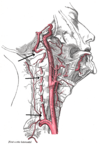SDL 3 - Brain, Meninges & Blood Supply Flashcards
What is meant by ‘rostral’ and ‘caudal’?
Rostral:
- this is used to describe the position of a structure with reference to the nose
- Occurring near the front end of the body
Caudal:
- towards the tail end or the posterior part of the body

What is meant by the cephalic flexure?
The axis of the adult brain bends at an angle of 100 degrees between the midbrain and the diencephalon
this is the cephalic flexure

What terms are used to describe structures in the brain, relating to the cephalic flexure?
What does this mean?
The terms dorsal and ventral are used as though the flexure did not exist and the CNS was still a straight tube (as in the early embryo)
In the spinal cord and brainstem, dorsal means posterior
In the forebrain, dorsal means superior

Label the aspects of the forebrain and spinal cord


Label the diagram of the neurone


What is the difference between grey matter and white matter?
Grey matter:
- contains neuronal cell bodies
- also contains neuropil, glial cells, synapses and capillaries
White matter:
- contains axons coated in a myelin sheath
What is meant by ‘neuropil’?
Dendrites, as well as myelinated and non-myelinated axons
What is meant by the cortex?
Cortex is the outermost (or superficial) layer of an organ
The cerebral cortex is the outer portion of the cerebrum that is covered by the meninges, often referred to as grey matter
What is meant by nucleus?
A nucleus is a cluster of neurones within the CNS
they are located deep within the cerebral hemispheres and the brainstem
What is meant by ‘tract’ in neuroanatomy?
A bundle of nerve fibres (axons) connecting nuclei of the CNS
What is meant by ganglion?
A group of neurone cell bodies within the PNS

Label the ventral view of the brain


Label the midsagittal view of the brain


Which subdivisions of the brain make up the forebrain (or cerebrum)?
Telencephalon:
- contains cerebral cortex (2 cerebral hemispheres)
Diencephalon:
- contains the thalamus and hypothalamus
Which subdivisions of the brain make up the brainstem?
- Medulla oblongata
- Pons
- Midbrain
Label the lobes and structures of the brain


Are the cerebral lobes functional or descriptive subdivisions?
Functional
the cerebellum has four functionally and spatially defined lobes:
- Parietal
- Occipital
- Temporal
- Frontal
What is the formation of the dura mater like?
What structures does it form periodically?
It is formed from the periosteum lining the inside of the skull, together with a fibrous inner layer
throughout most of the cranial cavity, the two layers are tightly fused together
at some sites, the fibrous inner layer of dura separates from the periosteum to enclose blood-filled spaces - dural venous sinuses
What is contained within the dural venous sinuses?
Venous blood flows into them from the brain
At two sites of separation of the 2 layers of dura, what is formed?
The fibrous inner layer of dura projects into the cranial cavity to form a dural reflection (fold/septum)
this extends into the fissures between the major components of the brain
What is the name of the dural septum that extends down between the two cerebral hemispheres?
Falx cerebri

What is the name of the dural septum that extends between the occipital lobes of the hemispheres and the cerebellum?
Tentorium cerebelli

What is the function of the two dural septa?
They restrict rotary displacement of the brain
Label the structures indicated on the diagram
















